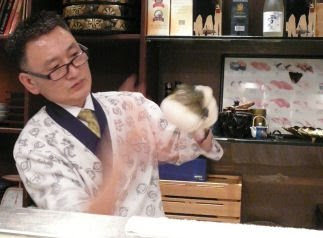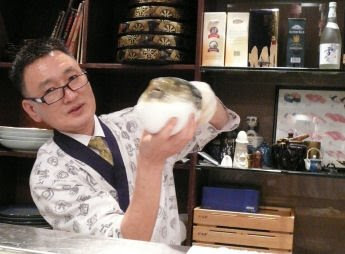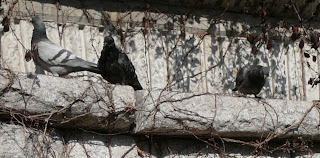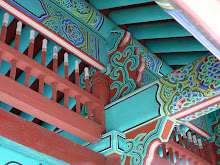
Our trip to Mongolia lasted only one week, but the break from Seoul was a much anticipated one. We flew through Beijing on our way to Ulaan Baator, which was a riot in its own sense. I'll break this trip up with subheadings, so you can scan for what looks interesting. The trip was lovely in its entirety and each little part was a treat on its own as well.
Getting There:We had booked the flights through Asiana Airlines, so we went to their check-in desk upon arrival at Incheon airport. They had, for some reason, booked us on a China Air flight, so they sent us from the Asiana desk to the China Air desk. We had a moment of perturbed wonder when we arrived at said desk and couldn't make out China Air from their airline neighbors, nor to which airline the long line of travelers belonged. I approached a desk that looked hopeful and asked the gentleman if he could help me.
Ironically, at the moment I reached the desk, Sasha later informed me, all of the signs for China Air flipped to "CLOSED." I had made my decision to approach in the nick of time!
I rummaged through my money belt first for the paper on which our flight information was stated, assuming that the man at the desk would want to see our confirmation number. He didn't. Instead he wanted my passport, for which he asked, but which was not in the money belt lying on the counter. It was in the purse slung across my shoulder. I directed my attention toward the purse in order to retrieve my passport and not a moment passed before the man had his hand IN my money belt. He had, mind you, no intention of stealing the cash or credit cards now readily available to his nosy fingers, but rather to help me get him what he wanted. "It isn't in there." was my most stern response with a hand just as sternly placed over the top of the belt on the counter. "Oh, sorry," he responded bashfully, pulling his hand back to his side of the desk.
This is the impatience I am vacationing from, I thought to myself. Then, keep your hands out of other people's places! Harrumph!
He issued our tickets to Beijing and told us we would have to check in again when we got there because Ulaan Baator
opsaiyo (doesn't exist). He meant that because we were flying another airline from Beijing to Mongolia, he was unable to issue the tickets straight through. I include the literal translation from the Korean here because I like the implications.
Beijing:Outside of the Beijing airport, I can not say that I have ever been to China. I do think, however, that I may include that country in the count the next time someone asks me how many countries I have been to (people don't ask too often, anyhow). Swine flew is a concern here, so before we were let off the plane, a man in a bright onesie and a face mask had to peer into the plane to clear us. I think e was supposed to be looking for people who looked unhealthy in some way, but really he just peaked in and left again. We were free to be in China.
The man at Incheon had told us to go directly to the transfer check-in desk, which was easy to find. It was right after the health check where censored cameras looked for people of more- or less-than-average temperatures. Sasha was asked to step aside and had his temperature taken. He runs low and they let him pass.
Two women sat at the transfer desk. One woman checked our passports and connection information and the other chatted at her. We were given hand-written boarding passes (that turned out to be more like hall passes for the airport) and the chatty woman stopped chatting and asked us to follow her. I assumed, for whatever reason, that we would be led around the corner and directed to go "down this hall, through the doors, turn left and up the stairs..." but she personally led us down the hall, to the right and around a corner, through an immigration point, where our passports were checked and stamped (see, I have been there!), down some stairs and through a security station, to the left, I think through another check point, through some doors and put on a bus. The lady left us once we were on the bus. Good thing she stuck around that long, too, because I have no idea how we would have gotten there on our own. And, dear readers, I believe that was the point.
We were the only passengers on this bus and we were not sure where it was going to leave us. We began to get this idea that Ulaan Baator was a far off place. Maybe the plane is really small, we thought. We are going to end up in a dingy old terminal built 70 years ago and kept up only for occasional puddle jumper flights to Mongolia, we imagined. The bus took off around one corner, then another, then out into the open. The open? Hey, at least the driver stopped to look both ways before crossing the tarmac. Every time. We were driven across runways as planes came in for landing and took off. As we crossed I looked down the runway, knowing the plane I saw was hundreds of yards away, but also moving toward us at a fast pace.
We believed we were definitely off the beaten path. Sasha is fond of recalling that the X Files were playing on the television in the bus. It was the episode where a little girl is talking to a baby doll that tells her to do horrible things to her loved ones--or something of equal creepiness. We swung by an army base of some sort, passing soldiers marching down the road and a truck with soldiers sitting on all flat surfaces available for sitting. I get it, I finally said, he's driving us to Mongolia.
Not so. We soon stopped at a door and were signaled to deboard. A man was waiting for us and calls us into this place that is almost what the last place was (did we drive in a big circle?). He inspected our passports, stapled our hall passes to perfectly modern boarding passes for an Air Mongolian flight and sent us up a staircase. Alas, we were in an up to date airport terminal complete with Duty Free and Starbucks.
At the gate we noted strangers socializing with one another, striking up conversations and such, like we haven't seen in Korea in our many months here. We would reflect on this often while away. The flight to Ulaan Baator was not a vacant puddle jumper, but rather a full 747 (or some big number). The turbulence was rough enough to have me practicing meditative breathing to save my sanity for a good part of the flight, but we arrived safely.
My first word upon exiting the airport in U.B. was "Grass." I hadn't smelled grass since being in Maui in May. Even then the ocean was so overpowering that I think it had been close to a year since I had smelled fresh, live, green grass. Welcome to Mongolia!
Ulaan Baator:It was late and very dark when we arrived. The hostel van picked us up and we traveled with another couple the short distance from the airport into the city. The following morning we set out for the western part of the country, so we had very little time in the city before continuing on to Lake Huvsgal. However, after five days on the lake, we returned to the city for another two days. I will share our impressions here.
Having lived in Seoul for the past six months, we were looking for a break from the rush of the city and the masses of people. We are still very much entangled in the emotions and frustrations that come along with inter-cultural living (culture shock?), and so our impressions of any place other than Seoul may have been biased on these grounds alone. To give credit where credit is due, however, vacation experiences are always different from living experiences, our understanding of a place remaining trivial at best, perhaps superficial.
Ulaan Baator is not excluded from this rule. I loved the city with its rush and its many people. I appreciated its chaos as charming and its dirt and dilapidation as rawness, suggesting a life somehow realer than my own.
We set out by foot in the morning, thankful that our hostel was within walking distance to most sites. Taxis are unidentified in UB and most every car can serve as a taxi. Negotiating price and destination can be difficult to outsiders, and we were not up for trying it.
The first thing I noticed was how people interact in space. In Korea, most people walk on the left side of the walkway, but often stop erratically and shift sides without warning. Many months in the thick of it has allowed me the time and experience necessary to negotiate my way in crowds into and out of the subway, but I am still very aware of the difference in my sense of space in walking and passing and crossing streets than that of the Korean's. In UB it was different again. Walking was perfectly comfortable for me, perhaps due to the fact that there was simply more space on the sidewalks (i.e. fewer people!), but I had to force myself to initiate the crossing of any street. Cars drove in every direction at any given time, to the point that many larger streets had three-foot-high fences down the center line to keep cars from pulling u-turns in the middle of the street. They were also meant to keep pedestrians from crossing the street in the middle of a block, I was told.
This can be related to the situation we encountered outside of the city, where all roads are dirt tracks. When one track gets too difficult to travel, a driver simply pulls aside and begins to cut a new trail. From the sky the earth looks like a broad grassland laced with brown ribbons, all running in the same direction and meeting at the same destination. I thought of Mongolia's nomadic history in which the horses just ran, no pavement necessary, and my mind found logic in assuming the traffic was based on a culture unaccustomed to confinement. In my two days in the town, my vacationer's ignorance was happy to believe this to be the case. I haven't spent much time thinking of it since leaving.
Toward the end of our second day in the city, I felt like I was getting a hang of my surroundings. Wouldn't it be wonderful to stay a while, learn the language, get to know this beautiful country and its beautiful people? We praised the food, the friendliness, the differences and the similarities, and we smiled at each other when one of us said the words we had both thought many times: that is it far easier to appreciate everything about a place that you don't have to involve yourself in than a place on which your basic comfort and survival depend.
We had finished drinks at the German pub a few blocks from our hostel and started back to pack our bags and be ready to fly early in the morning. It was dark. The light turned and we crossed the street. I was being offensive, I thought, when I strutted into the road. A Mongolian crossing next to us didn't walk, but rather jogged. We jogged, too--if the locals do it, there may be a reason. A car flew around the corner, not breaking. I don't know if it had headlights on. Had we walked, we would have been hit.
An early morning at the parliament building. Chingis Khan sits proudly atop the center stairs.

UB resembles other Soviet satellite states that I have visited. Imposing statues and crumbling buildings are found throughout the city. Much is in need of repair. Much is disorganized to the foreigner's eye (again, a symptom of the vacationer). The effort to increase tourism is seen in the many souvenir shops present as well as in the fact that ethnic restaurants abound. We ate better Latin food in UB than we have found in all of Seoul.
This sculpture--not imposing, but rather playful--was my favorite overall.

The tour books advise foreigners to carry important documents in money belts, and this message, coupled with the run-down atmosphere, made UB feel like a raw place. We protected our valuables. We had no troubles. We found a Korean grocery store and felt relieved that we could understand what was what.
At Lake Huvsgal:From UB, we flew to Murun, as small city in the north west part of Mongolia, and met our tour guide, Gamba. We had lunch and climbed into the Land Cruiser that would carry us the 100 kilometers north to Lake Huvsgal. The Toyota included a driver, whose name I do not remember. He spoke no English and did his best not to speak Mongolian either. Very quiet gentleman, he was.
When we arrived at the lake, we had been in the vehicle, bouncing to and fro, for three hours. We were relieved to reach our final destination. For the next four nights, we would sleep in a world silent except for the sounds of
ger doors shutting tight, wood fires cracking and thunderstorms passing through the wide country.

We went for a boat ride one day and rode horses another day.
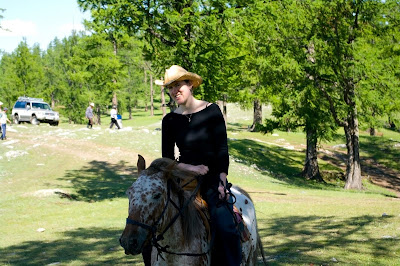
Outside of these fun enough activities, we relaxed an enjoyed the black pines surrounding our camp.

Our
ger was not so small in reality. The angle of this shot makes Mongolia look much smaller than it really is.

A perfect shot of nature's colors.







 Springtime is slowly bringing green into Seoul. Blossoms are softening the stark cityscape of dull cement, plastic and glass. I am told that outside of Seoul is the place to be this time of year, but powers beyond our control keep us here for the time being, and so we must make do with the nature around us.
Springtime is slowly bringing green into Seoul. Blossoms are softening the stark cityscape of dull cement, plastic and glass. I am told that outside of Seoul is the place to be this time of year, but powers beyond our control keep us here for the time being, and so we must make do with the nature around us.



